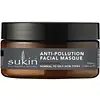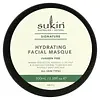What's inside
What's inside
 Key Ingredients
Key Ingredients

 Benefits
Benefits

 Concerns
Concerns

 Ingredients Side-by-side
Ingredients Side-by-side

Water
Skin ConditioningKaolin
AbrasiveBentonite
AbsorbentStearic Acid
CleansingCetyl Alcohol
EmollientCetearyl Alcohol
EmollientGlyceryl Stearate
EmollientCaprylic/Capric Triglyceride
MaskingCeteareth-20
CleansingPersea Gratissima Oil
Skin ConditioningRosa Canina Fruit Oil
EmollientCharcoal Powder
AbrasiveBiosaccharide Gum-4
Skin ConditioningCydonia Oblonga Leaf Extract
Skin ConditioningCocos Nucifera Oil
MaskingAloe Barbadensis Leaf Juice
Skin ConditioningCucumis Sativus Fruit Extract
EmollientMoringa Oleifera Leaf Extract
Skin ConditioningAspalathus Linearis Leaf Extract
Skin ConditioningChamomilla Recutita Flower Extract
MaskingEpilobium Angustifolium Extract
Skin ConditioningPunica Granatum Fruit Extract
AntioxidantVaccinium Myrtillus Fruit Extract
Skin ConditioningGlycerin
HumectantTocopherol
AntioxidantXanthan Gum
EmulsifyingCitrus Nobilis Peel Oil
MaskingLavandula Angustifolia Oil
MaskingBackhousia Citriodora Leaf Oil
MaskingCitrus Aurantifolia Oil
CleansingCitrus Aurantium Amara Leaf/Twig Oil
MaskingCitric Acid
BufferingPhenoxyethanol
PreservativeBenzyl Alcohol
PerfumingLimonene
PerfumingLinalool
PerfumingWater, Kaolin, Bentonite, Stearic Acid, Cetyl Alcohol, Cetearyl Alcohol, Glyceryl Stearate, Caprylic/Capric Triglyceride, Ceteareth-20, Persea Gratissima Oil, Rosa Canina Fruit Oil, Charcoal Powder, Biosaccharide Gum-4, Cydonia Oblonga Leaf Extract, Cocos Nucifera Oil, Aloe Barbadensis Leaf Juice, Cucumis Sativus Fruit Extract, Moringa Oleifera Leaf Extract, Aspalathus Linearis Leaf Extract, Chamomilla Recutita Flower Extract, Epilobium Angustifolium Extract, Punica Granatum Fruit Extract, Vaccinium Myrtillus Fruit Extract, Glycerin, Tocopherol, Xanthan Gum, Citrus Nobilis Peel Oil, Lavandula Angustifolia Oil, Backhousia Citriodora Leaf Oil, Citrus Aurantifolia Oil, Citrus Aurantium Amara Leaf/Twig Oil, Citric Acid, Phenoxyethanol, Benzyl Alcohol, Limonene, Linalool
Water
Skin ConditioningCetearyl Alcohol
EmollientGlyceryl Stearate
EmollientGlycerin
HumectantHelianthus Annuus Seed Oil
EmollientCoco-Caprylate
EmollientPersea Gratissima Oil
Skin ConditioningMangifera Indica Fruit Extract
Skin ConditioningCarica Papaya Fruit Extract
Skin ConditioningAnanas Sativus Fruit Extract
Skin ConditioningOlea Europaea Fruit Oil
MaskingSimmondsia Chinensis Seed Oil
EmollientButyrospermum Parkii Butter
Skin ConditioningTocopherol
AntioxidantCetearyl Glucoside
EmulsifyingSodium Stearoyl Glutamate
CleansingXanthan Gum
EmulsifyingLactic Acid
BufferingAlcohol Denat.
AntimicrobialPhenoxyethanol
PreservativeBenzyl Alcohol
PerfumingParfum
MaskingWater, Cetearyl Alcohol, Glyceryl Stearate, Glycerin, Helianthus Annuus Seed Oil, Coco-Caprylate, Persea Gratissima Oil, Mangifera Indica Fruit Extract, Carica Papaya Fruit Extract, Ananas Sativus Fruit Extract, Olea Europaea Fruit Oil, Simmondsia Chinensis Seed Oil, Butyrospermum Parkii Butter, Tocopherol, Cetearyl Glucoside, Sodium Stearoyl Glutamate, Xanthan Gum, Lactic Acid, Alcohol Denat., Phenoxyethanol, Benzyl Alcohol, Parfum
Ingredients Explained
These ingredients are found in both products.
Ingredients higher up in an ingredient list are typically present in a larger amount.
Benzyl Alcohol is most commonly used as a preservative. It also has a subtle, sweet smell. Small amounts of Benzyl Alcohol is not irritating and safe to use in skincare products. Most Benzyl Alcohol is derived from fruits such as apricots.
Benzyl Alcohol has both antibacterial and antioxidant properties. These properties help lengthen the shelf life of products. Benzyl Alcohol is a solvent and helps dissolve other ingredients. It can also improve the texture and spreadability.
Alcohol comes in many different forms. Different types of alcohol will have different effects on skin. This ingredient is an astringent alcohol.
Using high concentrations of these alcohols are drying on the skin. They may strip away your skin's natural oils and even damage your skin barrier. Astringent alcohols may also irritate skin.
Other types of astringent alcohols include:
According to the National Rosacea Society based in the US, you should be mindful of products with these alcohols in the top half of ingredients.
Any type of sanitizing product will have high amounts of alcohol to help kill bacteria and viruses.
Learn more about Benzyl AlcoholCetearyl alcohol is a mixture of two fatty alcohols: cetyl alcohol and stearyl alcohol. It is mainly used as an emulsifier. Emulsifiers help prevent the separation of oils and products. Due to its composition, it can also be used to thicken a product or help create foam.
Cetearyl alcohol is an emollient. Emollients help soothe and hydrate the skin by trapping moisture.
Studies show Cetearyl alcohol is non-toxic and non-irritating. The FDA allows products labeled "alcohol-free" to have fatty alcohols.
This ingredient is usually derived from plant oils such as palm, vegetable, or coconut oils. There is debate on whether this ingredient will cause acne.
Due to the fatty acid base, this ingredient may not be Malassezia folliculitis safe.
Learn more about Cetearyl AlcoholGlycerin is already naturally found in your skin. It helps moisturize and protect your skin.
A study from 2016 found glycerin to be more effective as a humectant than AHAs and hyaluronic acid.
As a humectant, it helps the skin stay hydrated by pulling moisture to your skin. The low molecular weight of glycerin allows it to pull moisture into the deeper layers of your skin.
Hydrated skin improves your skin barrier; Your skin barrier helps protect against irritants and bacteria.
Glycerin has also been found to have antimicrobial and antiviral properties. Due to these properties, glycerin is often used in wound and burn treatments.
In cosmetics, glycerin is usually derived from plants such as soybean or palm. However, it can also be sourced from animals, such as tallow or animal fat.
This ingredient is organic, colorless, odorless, and non-toxic.
Glycerin is the name for this ingredient in American English. British English uses Glycerol/Glycerine.
Learn more about GlycerinGlyceryl Stearate is a mix of glycerin and stearic acid.
It is used to stabilize the mixing of water and oil ingredients. By preventing these ingredients from separating, it can help elongate shelf life. It can also help thicken the product's texture.
As an emollient, it helps soften skin and supports barrier-replenishing ingredients.
In cosmetics, Glyceryl Stearate is often made from vegetable oils or synthetically produced.
This ingredient may not be fungal-acne safe
Fun fact: The human body also creates Glyceryl Stearate naturally.
Learn more about Glyceryl StearatePersea Gratissima Oil is also known as avocado oil.
Avocado Oil has antioxidant properties. It is mostly made up of the glycerides of fatty acids. About 67% of these fatty acids is made up of oleic acid. Palmitic acid and linoleic acid are also present.
These fatty acids help hydrate and soften the skin. It may increase collagen content in the skin. Collagen helps keep your skin plump and firm. This ingredient helps reduce inflammation and has not shown to clog pores.
This ingredient may not be fungal-acne safe due to its high fatty acid content.
Avocados also have B vitamins, vitamin K, vitamin C, vitamin E, and potassium.
Learn more about Persea Gratissima OilPhenoxyethanol is a preservative that has germicide, antimicrobial, and aromatic properties. Studies show that phenoxyethanol can prevent microbial growth. By itself, it has a scent that is similar to that of a rose.
It's often used in formulations along with Caprylyl Glycol to preserve the shelf life of products.
Tocopherol (also known as Vitamin E) is a common antioxidant used to help protect the skin from free-radicals and strengthen the skin barrier. It's also fat soluble - this means our skin is great at absorbing it.
Vitamin E also helps keep your natural skin lipids healthy. Your lipid skin barrier naturally consists of lipids, ceramides, and fatty acids. Vitamin E offers extra protection for your skin’s lipid barrier, keeping your skin healthy and nourished.
Another benefit is a bit of UV protection. Vitamin E helps reduce the damage caused by UVB rays. (It should not replace your sunscreen). Combining it with Vitamin C can decrease sunburned cells and hyperpigmentation after UV exposure.
You might have noticed Vitamin E + C often paired together. This is because it is great at stabilizing Vitamin C. Using the two together helps increase the effectiveness of both ingredients.
There are often claims that Vitamin E can reduce/prevent scarring, but these claims haven't been confirmed by scientific research.
Learn more about TocopherolWater. It's the most common cosmetic ingredient of all. You'll usually see it at the top of ingredient lists, meaning that it makes up the largest part of the product.
So why is it so popular? Water most often acts as a solvent - this means that it helps dissolve other ingredients into the formulation.
You'll also recognize water as that liquid we all need to stay alive. If you see this, drink a glass of water. Stay hydrated!
Learn more about WaterXanthan gum is used as a stabilizer and thickener within cosmetic products. It helps give products a sticky, thick feeling - preventing them from being too runny.
On the technical side of things, xanthan gum is a polysaccharide - a combination consisting of multiple sugar molecules bonded together.
Xanthan gum is a pretty common and great ingredient. It is a natural, non-toxic, non-irritating ingredient that is also commonly used in food products.
Learn more about Xanthan Gum